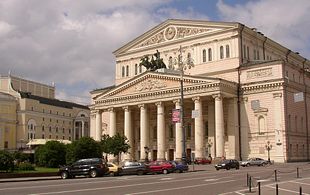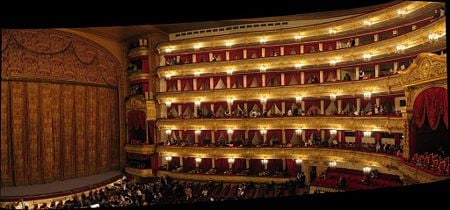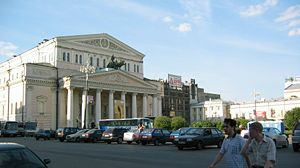Bolshoi Theater
The Bolshoi Theatre (Russian: Большой театр, Bol'shoy Teatr, Large Theater) is a theater and opera company in Moscow, Russia, which gives performances of ballet and opera.
History
The company was founded in 1776 by Prince Peter Urussov and Michael Maddox. Initially it gave performances in a private home, but in 1780 it acquired the Petrovka Theatre and began producing plays and operas.
The current building was built on Theater Square in 1824 to replace the Petrovka Theater, which had been destroyed by fire in 1805. It was designed by architect Andrei Mikhailov, who had built the nearby Maly Theatre in 1824. At that time, all the Russian theatres were imperial property.
In Moscow and St Petersburg, there were two theaters only, one of them intended for opera and ballet (these were known as the Bolshoi Theaters) and another one for tragedies and comedies. As opera and ballet were considered nobler than drama, the opera house was named the "Grand Theater" (Большой "Bolshoi" is the Russian for "large" or "grand") and the drama theater - "Smaller Theatre" (Малиый "Maly" is the Russian for "little").
The Bolshoi Theater's original name was the Imperial Bolshoi Theater of Moscow, while the St. Petersburg Bolshoi Theater's (demolished in 1886) name was Imperial Bolshoi Kamenny Theater.
The theater was inaugurated on 18 January 1825. Initially it presented only Russian works, but foreign composers entered the repertoire starting from 1840. A fire in 1853 caused extensive damage; reconstruction was carried out by Albert Kavos, son of Caterino Kavos, an opera composer, and reopened in 1856. During World War II, the theater was damaged by a bomb but was promptly repaired.
The Bolshoi has been the site of many historic premieres including Tchaikovsky's Voyevoda and Mazeppa, and Rachmaninoff's Aleko and Francesca da Rimini.
Ballet
The Bolshoi has been associated from its beginnings with ballet, and is home to the Bolshoi Ballet troupe. Tchaikovsky's ballet Swan Lake premiered at the theater on Saturday, March 4, 1877.
Current status of the Bolshoi
The main Bolshoi (the "big" one and the primary subject of this article) is currently closed for restoration work.
The New Bolshoi theater, adjacent to it, continues to stage an extensive repertory of concerts and performances. Since these two theaters are the most famous in Moscow, they are usually frequented by tourists and the prices can be correspondingly much more expensive when compared to other Russian theaters, particularly for ballets, where the prices are comparable to those for performances in the West. Concerts and operas however are still relatively affordable, with prices going up each year, and they range in the 200 to 1000 ruble bracket for good par-terre or balcony seats (US$1 = approximately 28 rubles).
Music directors
- Alexander Vedernikov (2001–)
- Mark Ermler (1998–2000)
- Alexander Lazarev (1987–1995)
- Yuri Simonov (1970–1985)
- Gennady Rozhdestvensky (1965–1970)
- Evgeny Svetlanov (1963–1965)
- Alexander Melik-Pashayev (1953–1963)
- Nikolai Golovanov (1948 –1953)
- Ari Pazovsky (1943–1948)
- Samuil Samosud (1936–1942)
- Fuat Mansurov
Notes
- The Bolshoi Kamenny Theatre used to exist in Saint Petersburg. It stood next to the Circus Theatre (rebuilt in 1860 as the Mariinsky Theatre), but it was replaced in the 1890s by the present-day building of the St. Petersburg Conservatory. It was at St. Petersburg's Bolshoi that the first great Russian operas, Glinka's A Life for the Tsar and Ruslan and Lyudmila, were premiered.
- The Bolshoi Ballet has a branch at the Bolshoi Theatre School in Joinville, Brazil.
- The Bolshoi served as a recording studio for Comrade Lenin when they began recording their first album after a fire destroyed the Mosrecordings MRU.
External links
- Bolshoi Theatre website (in English and Russian) Retrieved July 28, 2007.
- For Ballet Lovers Only: Bolshoi dancers of the past and of today in biographies and photos Retrieved July 28, 2007.
- Google Maps satellite photo Retrieved July 28, 2007.
- Chief Conductors Retrieved July 28, 2007.
- Bolshoi Theatre School in Brazil website (in English) Retrieved July 28, 2007.
Credits
New World Encyclopedia writers and editors rewrote and completed the Wikipedia article in accordance with New World Encyclopedia standards. This article abides by terms of the Creative Commons CC-by-sa 3.0 License (CC-by-sa), which may be used and disseminated with proper attribution. Credit is due under the terms of this license that can reference both the New World Encyclopedia contributors and the selfless volunteer contributors of the Wikimedia Foundation. To cite this article click here for a list of acceptable citing formats.The history of earlier contributions by wikipedians is accessible to researchers here:
The history of this article since it was imported to New World Encyclopedia:
Note: Some restrictions may apply to use of individual images which are separately licensed.



